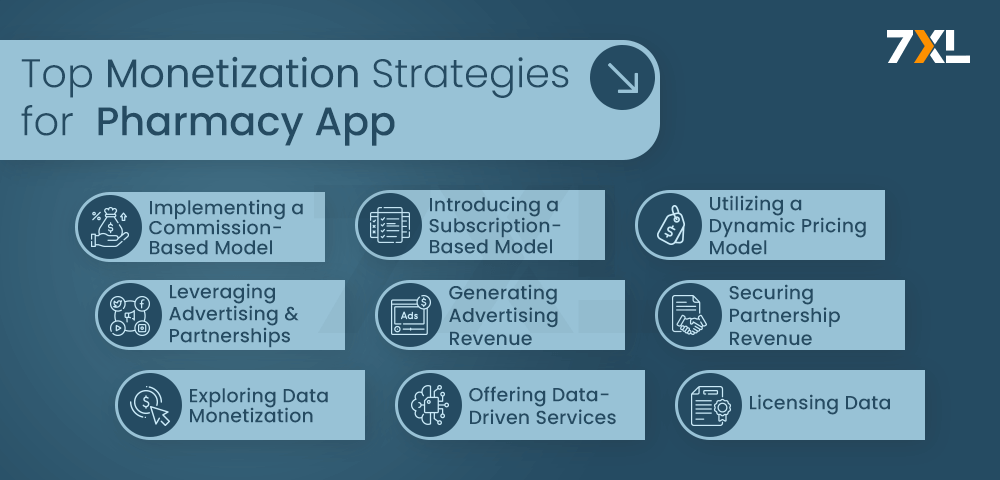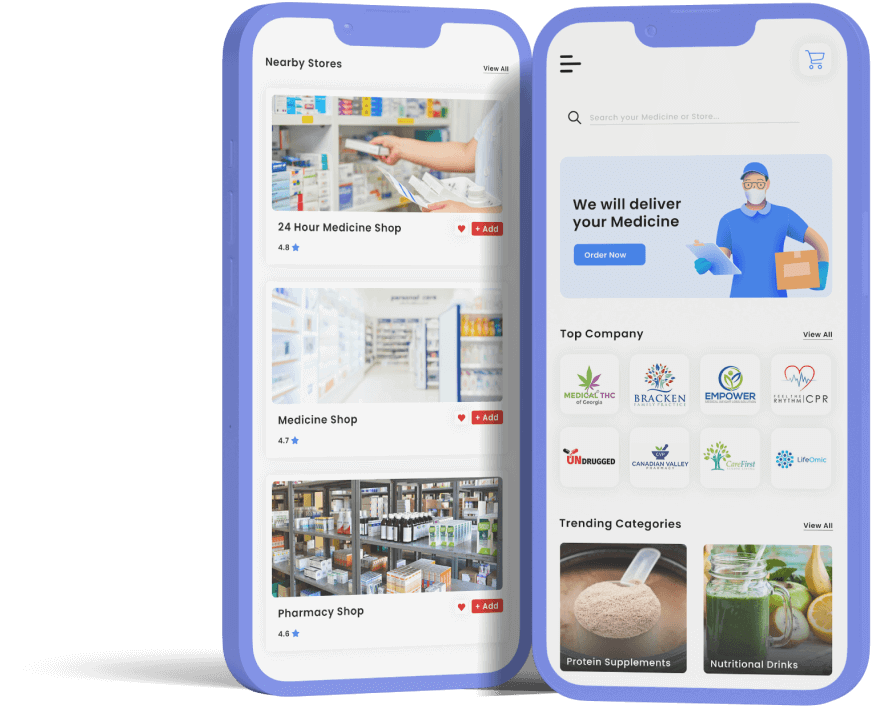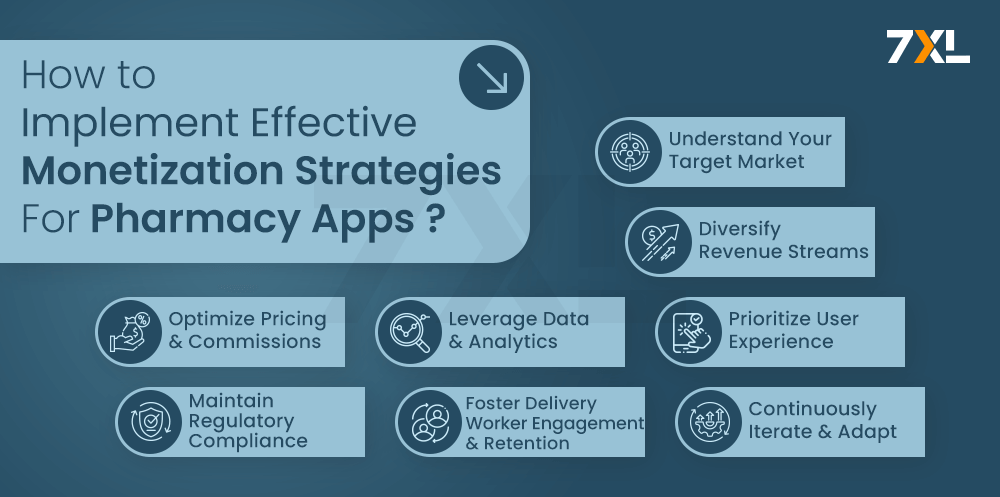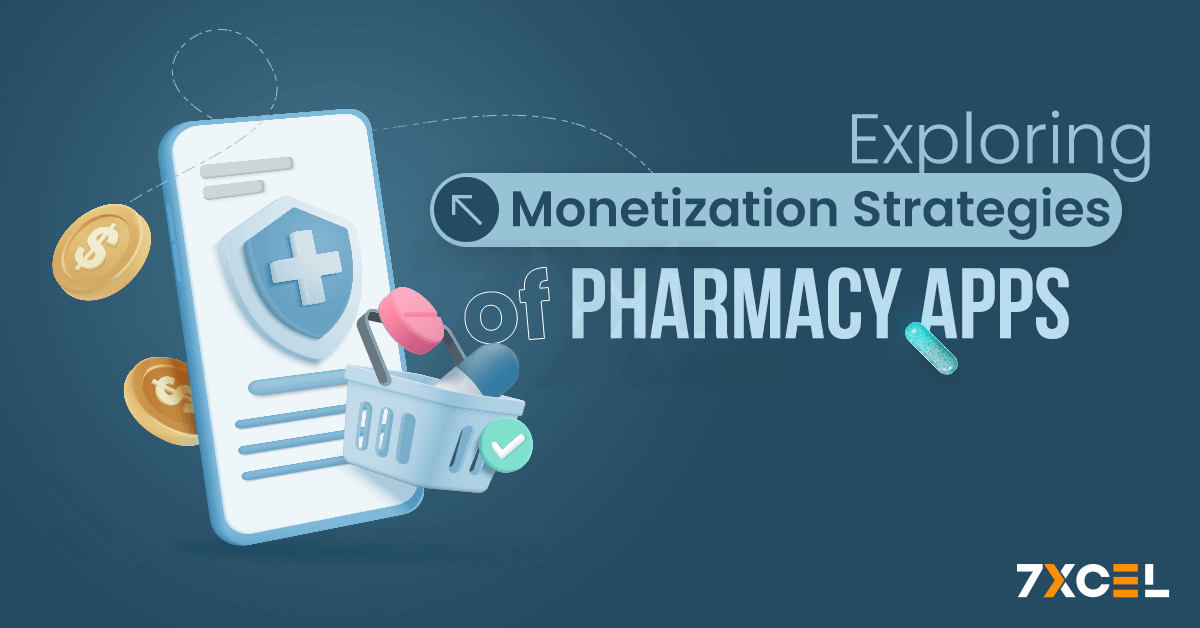Quick Summary:
In this mobile first era, pharmacy app monetization strategies have become essential for healthcare experts and businesses aiming to maximize revenue. With the right approaches, pharmacy apps can not only enhance user experience but also generate significant profits. In this blog, we’ll explore the most effective strategies to monetize your pharmacy app and drive sustainable growth.
Pharmacy apps have significantly changed the way people manage their medications, refill prescriptions, and access healthcare information, offering unprecedented convenience. However, their success isn’t just about a smooth user experience and quick delivery services. To thrive and grow, these apps must also implement smart monetization strategies that ensure they remain financially sustainable in the long run. Balancing user satisfaction with profitability is key to their ongoing success in the evolving healthcare landscape.
In this complete blog, we will delve into the top monetization methods employed by leading pharmacy apps, exploring the various revenue streams that enable these apps to generate profits and thrive in the competitive healthcare technology market.
Top Monetization Strategies for Pharmacy App
Unlock the revenue potential of your pharmacy app with these top monetization strategies. From Commission model and subscription models to advertising learn how to effectively generate income while delivering value to your users and growing your business sustainably. Here is the breakdown of each model in detail:

Commission-Based Model
One of the most common revenue models for pharmacy apps is the commission-based approach. In this model, the app takes a percentage of each transaction as a commission, typically ranging from 5% to 15% depending on the local market conditions and competitive pricing.
The commission based model is appealing for several reasons:
- Scalable Revenue: As the number of transactions on the app increases, the platform’s revenue scales proportionally, making it a highly scalable model.
- Alignment of Interests: The commission-based model aligns the interests of the pharmacy app, the customers, and the participating pharmacies. The app’s success is directly tied to the growth and utilization of the platform, incentivizing all parties to work towards a common goal.
- Minimal Upfront Costs: Pharmacy apps that employ the commission-based model do not need to invest in inventory or maintain a physical retail presence. They can leverage the existing infrastructure and supply chains of their pharmacy partners, reducing the upfront capital requirements
However, the commission based model also presents some challenges:
- Potential Pharmacy Dissatisfaction: Pharmacies may feel that the commission charged by the pharmacy app is too high, leading to potential conflicts and strained relationships.
- Regulatory Scrutiny: Regulatory bodies may scrutinize the commission-based model, particularly in terms of patient privacy, data security, and the classification of delivery workers as independent contractors.
- Competitive Pressure: As the pharmacy app market becomes more saturated, platforms may need to adjust their commission rates to remain competitive, which can impact overall profitability.
To address these challenges, pharmacy apps can consider implementing dynamic pricing strategies, offering tiered commission structures based on volume or performance, and fostering strong partnerships with their pharmacy partners to ensure mutual benefits and alignment of interests.
Subscription-Based Model
Another popular monetization strategy for pharmacy apps is the Subscription-Based model. In this approach, users pay a recurring fee, generally on a monthly or annual basis, to access the platform’s services and features.
The Subscription-Based model offers several advantages:
- Predictable Revenue Stream: Better financial planning and forecasting are made possible by the more steady and predictable income stream that subscription-based revenue for the pharmacy app delivers.
- Increased Customer Loyalty: Due to their personal incentive to get the most out of their subscription, users of the pharmacy app are more likely to stick with it.
- Potential for Upselling: The pharmacy app can offer additional premium features or services to subscribers, creating opportunities for further revenue generation.
However, the Subscription-Based model also presents its own set of challenges:
- Acquiring and Retaining Subscribers: Convincing users to commit to a Subscription-Based model can be challenging, especially in a competitive market where free or commission-based options are available.
- Balancing Subscription Fees: The pharmacy app must strike the right balance between subscription fees and the perceived value of the service to ensure affordability and profitability.
- Potential Cannibalization of Commission-based Revenue: Introducing a subscription model may lead to a decrease in commission-based revenue if users opt for the subscription option instead of individual transactions.
To address these challenges, pharmacy apps can consider offering tiered subscription plans with varying levels of features and benefits, providing free trial periods to encourage user adoption, and leveraging datadriven insights to optimize their subscription pricing and offerings.
Dynamic Pricing Model
The dynamic pricing model, also known as surge pricing, is a strategy where the pharmacy app adjusts delivery fees or service charges based on realtime supply and demand factors, such as peak hours, weather conditions, and special events.
The dynamic pricing model offers several advantages:
- Demand Management: Dynamic pricing helps the pharmacy app manage demand by incentivizing delivery workers to be available during highdemand periods and discouraging users from requesting deliveries during peak times.
- Revenue Optimization: By adjusting prices based on supply and demand, the pharmacy app can maximize revenue and profitability.
- Improved User Experience: Dynamic pricing can help ensure that users can consistently find available delivery workers, even during periods of high demand.
However, the dynamic pricing model also presents some challenges:
- Potential User Backlash: Sudden and significant price increases during peak times may be perceived as unfair by users, leading to customer dissatisfaction and potential regulatory scrutiny.
- Delivery Worker Compensation Concerns: Delivery workers may feel that the pharmacy app is unfairly profiting from the dynamic pricing model, leading to potential conflicts and worker turnover.
- Complexity of Implementation: Effectively implementing a dynamic pricing model requires sophisticated algorithms and data analysis to accurately predict & respond to changes in supply and demand.
To address these challenges, pharmacy apps can focus on transparent communication with users about the factors driving dynamic pricing, ensure fair compensation for delivery workers, and continuously refine their pricing algorithms to optimize for both user satisfaction and profitability.
Collaborating with a specialized Pharmacy App Development Company can help in implementing these strategies effectively. Their expertise ensures that the app is designed to manage dynamic pricing transparently, while also balancing operational costs and customer expectations, leading to a more reliable and user-friendly platform.
Advertising and Partnerships
Pharmacy apps can generate additional revenue through advertising and strategic partnerships with complementary businesses, such as healthcare providers, insurance companies, and pharmaceutical manufacturers.
Advertising Revenue
In app Advertising: The pharmacy app can sell advertising space within the app, allowing businesses to reach a targeted audience of users. Sponsored Content: The pharmacy app can offer sponsored content, such as featured promotions or branded experiences, to generate revenue.
Partnership Revenue
- Affiliate Marketing: The pharmacy app can earn commissions by referring users to partner businesses, such as healthcare providers or insurance companies.
- Co-branded Offerings: The pharmacy app can collaborate with partners to create co-branded products or services, sharing the revenue generated.
The advantages of advertising and partnerships include:
- Diversified Revenue Streams: Advertising and partnerships can provide additional revenue sources, reducing the pharmacy app’s reliance on commission-based or Subscription-Based models.
- Leveraging Existing User Base: The pharmacy app can monetize its user base by offering targeted advertising and partnership opportunities to businesses.
- Enhancing User Experience: Carefully curated partnerships and sponsored content can enhance the user experience and provide additional value to customers.
However, the challenges include:
- Balancing User Experience: Integrating advertising and partnerships into the app must be done in a way that does not disrupt the user experience or undermine the app’s core value proposition.
- Maintaining Relevance: The pharmacy app must continuously identify and secure partnerships that are relevant and valuable to its user base, which can be a time consuming and resource intensive process.
- Regulatory Compliance: Advertising and partnerships may be subject to various regulations, such as data privacy laws and disclosure requirements, which must be carefully navigated.
To address these challenges, pharmacy apps can focus on creating a seamless and unobtrusive advertising experience, prioritize partnerships that align with their brand and user preferences, and ensure strict compliance with all relevant regulations.
Data Monetization
Pharmacy apps collect a vast amount of data, including user behavior, medication history, and delivery logistics. This data can be monetized by the app in various ways.
Data driven Services
- Predictive Analytics: The pharmacy app can leverage its data to provide predictive analytics services, such as medication adherence monitoring or supply chain optimization, to healthcare providers or pharmaceutical companies.
- Targeted Advertising: Businesses can take advantage of the pharmacy app’s data and insights into user preferences and behavior to receive highly targeted advertising opportunities.
Data Licensing
- Data Licensing to Third Parties: The pharmacy app can license its data to third-party organizations, such as research firms or healthcare analytics companies, for a fee.
- Data-as-a-Service (DaaS): The pharmacy app can offer a DaaS model, where it provides access to its data through an API or data platform, generating revenue from subscription fees or usage based pricing.
The advantages of data monetization include:
- Monetizing Existing Assets: The pharmacy app can generate additional revenue by leveraging the valuable data it has already collected, without requiring significant additional investment.
- Competitive Advantage: The app’s datadriven insights can provide a competitive edge, allowing it to offer unique services or optimize its own operations.
- Diversified Revenue Streams: Data monetization can serve as a complementary revenue source, reducing the app’s reliance on commission-based or Subscription-Based models.
However, the challenges include:
- Data Privacy and Regulations: The pharmacy app must ensure strict compliance with data privacy laws and regulations, such as HIPAA, which can be complex and evolving.
- Data Quality and Reliability: The app must maintain highquality, reliable data to ensure the accuracy and credibility of its datadriven services and offerings.
- Competitive Landscape: As the pharmacy app market matures, other platforms may also seek to monetize their data, increasing competition in this revenue stream.
To address these challenges, pharmacy apps can focus on transparent data collection and usage practices, invest in data quality and security measures, and explore unique data driven services that leverage their specific market insights and competitive advantages.

Ready to prescribe convenience right to your customers’ doors?
Empower patients with the tap of a button – your pharmacy, their pocket
Implementing Effective Monetization Strategies
Developing a successful revenue model for a pharmacy app requires a strategic and multifaceted approach. Here are some best practices to consider:

Understand Your Target Market:
To comprehend the requirements, inclinations, and problems that your target consumers and pharmaceutical partners are facing, conduct in-depth market research. This will enable you to modify your monetization plans in accordance with their particular needs.
Diversify Revenue Streams:
Implement a mix of revenue models, such as commission-based, Subscription-Based, and advertising/partnerships, to create a balanced and resilient revenue structure. By doing this, you can lessen the dangers that come with depending just on one source of income.
Optimize Pricing and Commissions:
Carefully analyze your costs, market conditions, and user behaviour to set competitive and sustainable pricing and commission structures. Regularly review and adjust these parameters to maintain profitability and user satisfaction.
Leverage Data and Analytics:
Utilize the wealth of data collected by your pharmacy app to generate valuable insights that can inform your monetization strategies. This may include predictive analytics, targeted advertising, and data licensing opportunities.
Prioritize User Experience:
Ensure that your monetization strategies enhance, rather than detract from, the user experience. Seamless integration of revenue generating features and transparent pricing can help build trust and loyalty among your users.
Maintain Regulatory Compliance:
Stay up-to-date with the evolving regulatory landscape and ensure that your monetization practices adhere to all relevant laws and regulations, particularly in areas such as data privacy, patient confidentiality, and consumer protection.
Foster Delivery Worker Engagement and Retention:
Develop monetization strategies that align the interests of your platform, users, and delivery workers. Ensure fair compensation and incentives for your delivery workforce to maintain a reliable and satisfied workforce.
Continuously Iterate and Adapt:
Monitor the performance of your monetization strategies, gather feedback from users and delivery workers, and be prepared to adapt and pivot as market conditions and user preferences evolve.
By implementing these best practices and leveraging the diverse revenue models discussed in this blog, pharmacy app developers and owners can unlock the full potential of their platforms and establish sustainable and profitable businesses in the dynamic healthcare technology landscape.
Conclusion
The pharmacy app market is growing due to demand for accessible healthcare services. Success relies on user experience and effective monetization strategies. Top methods include commission-based models, subscription-based offerings, dynamic pricing, advertising, and data monetization. Understanding these strategies helps entrepreneurs make informed decisions, allocate resources effectively, and position their platforms for long-term success. This blog provides valuable insights for both established and aspiring entrepreneurs.








